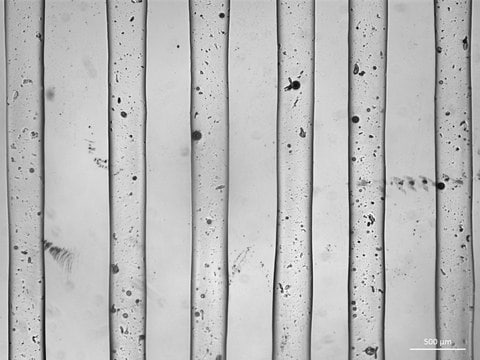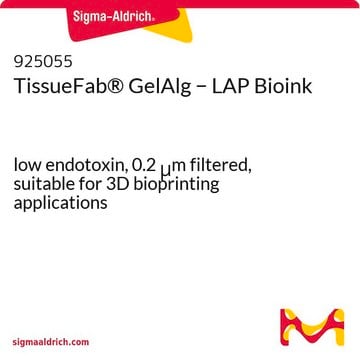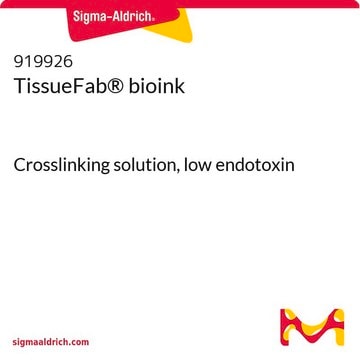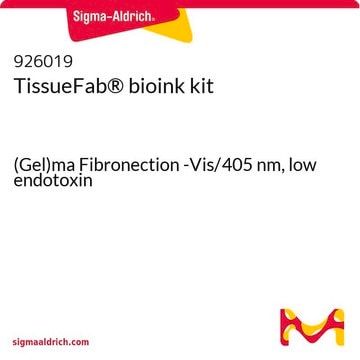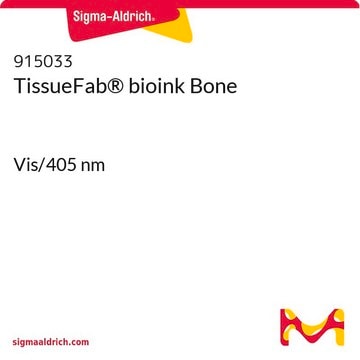추천 제품
설명
0.2 μm sterile filtered
suitable for 3D bioprinting applications
형태
viscous liquid
불순물
≤5 CFU/g Bioburden (Fungal)
≤5 CFU/g Bioburden (Total Aerobic)
색상
colorless to pale yellow
pH
6.5-7.5
응용 분야
3D bioprinting
저장 온도
2-8°C
유사한 제품을 찾으십니까? 방문 제품 비교 안내
관련 카테고리
일반 설명
애플리케이션
포장
기타 정보
- Optimize printing conditions (e.g., nozzle diameter, printing speed, printing pressure, temperature, cell density) for the features of your 3D printer and your application.
- Reduce bubble formation. Air bubbles in bioink may hamper bioprinting. Carefully handle the bioink when you mix and transfer it to avoid bubble formation. Do not vortex or shake vigorously.
Procedure
1. Prepare bioink: Keep TissueFab® - Sacrificial Bioink on ice to prevent gelation and gently invert the bioink to make a homogeneous solution. DO NOT vortex or shake vigorously. Transfer TissueFab® - Sacrificial Bioink into the desired printer cartridge.
2. Bioprint: Warm TissueFab® - Sacrificial Bioink in the printer cartridge to room temperature for 10–15 minutes to induce gelation. Follow the 3D printer manufacturer′s instructions. Load the print cartridge onto the 3D printer and print directly onto a Petri dish or into multi-well plates. Adjust the flow according to nozzle diameter, printing speed, printing pressure, and temperature. TissueFab® - Sacrificial Bioink can be printed in tandem with cell laden bioinks using additional printheads.
3. Optional Crosslink: If additional bioinks are used, crosslink the bioprinted structure before removing sacrificial scaffold following bioink instructions.
4. Remove sacrificial scaffold: Cool printed structure to 4 °C for at least 5 minutes. Rinse or perfuse with cold PBS.
5. Culture cells: Culture the bioprinted tissue with appropriate cell culture medium following standard tissue culture procedures.
법적 정보
Storage Class Code
10 - Combustible liquids
WGK
WGK 1
시험 성적서(COA)
제품의 로트/배치 번호를 입력하여 시험 성적서(COA)을 검색하십시오. 로트 및 배치 번호는 제품 라벨에 있는 ‘로트’ 또는 ‘배치’라는 용어 뒤에서 찾을 수 있습니다.
문서
약물 검사, 질병 모델링, 체외 장기 이식을 위해 바이오잉크를 기능성 조직 구조체로 3D 바이오프린팅할 수 있습니다. 특정 조직 공학 응용분야에 맞는 바이오잉크 및 분석법을 선택하십시오.
Bioinks enable 3D bioprinting of tissue constructs for drug screening and transplantation; select suitable bioinks for specific tissue engineering.
Learn how 3D bioprinting is revolutionizing drug discovery with highly-controllable cell co-culture, printable biomaterials, and its potential to simulate tissues and organs. This review paper also compares 3D bioprinting to other advanced biomimetic techniques such as organoids and organ chips.
Professor Shrike Zhang (Harvard Medical School, USA) discusses advances in 3D-bioprinted tissue models for in vitro drug testing, reviews bioink selections, and provides application examples of 3D bioprinting in tissue model biofabrication.
프로토콜
Frequently asked questions (FAQs) for KAPA SYBR® FAST One-Step qRT-PCR Kits.
자사의 과학자팀은 생명 과학, 재료 과학, 화학 합성, 크로마토그래피, 분석 및 기타 많은 영역을 포함한 모든 과학 분야에 경험이 있습니다..
고객지원팀으로 연락바랍니다.